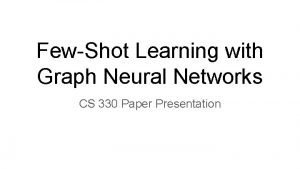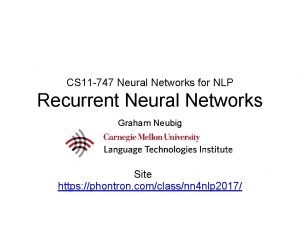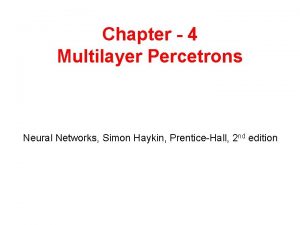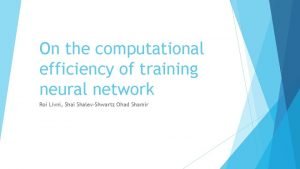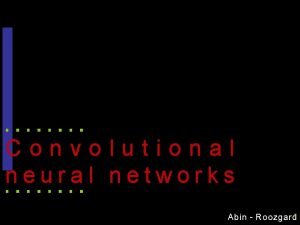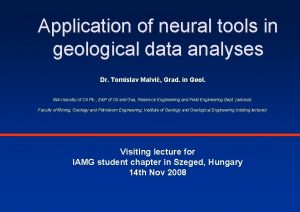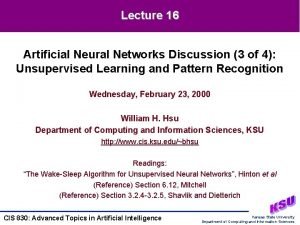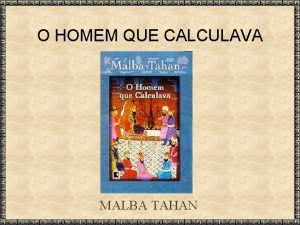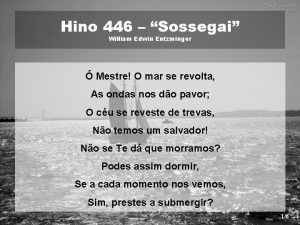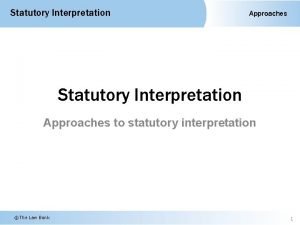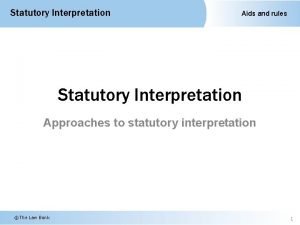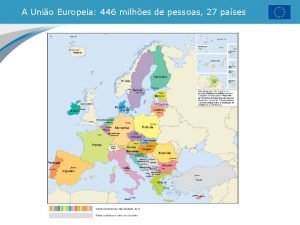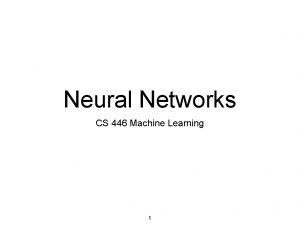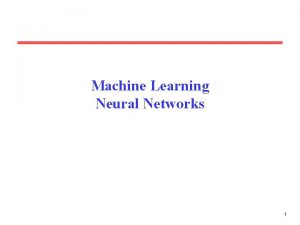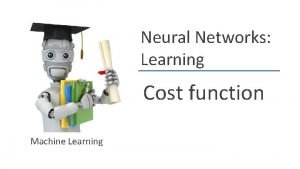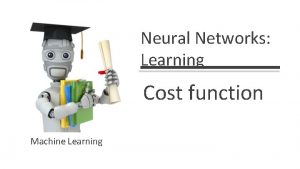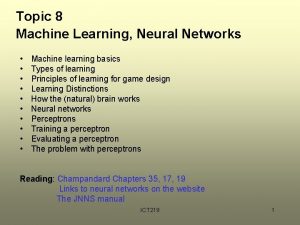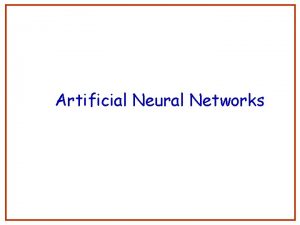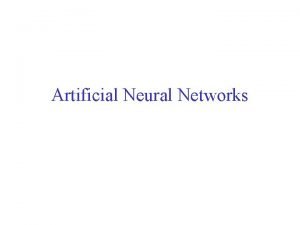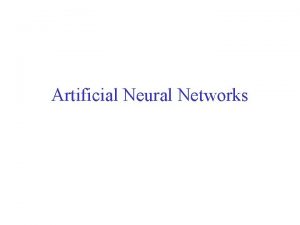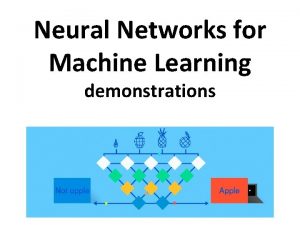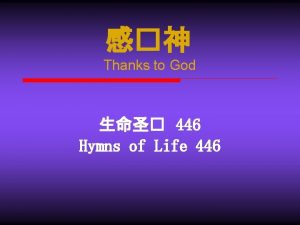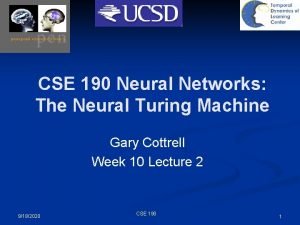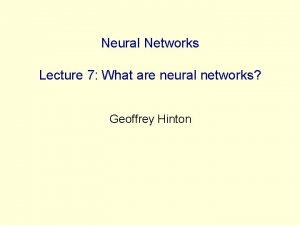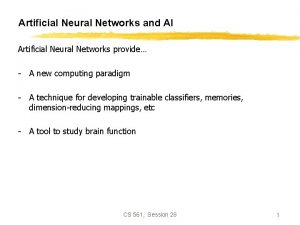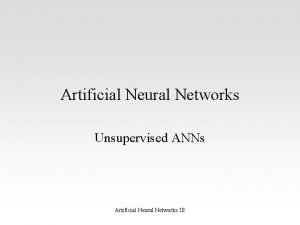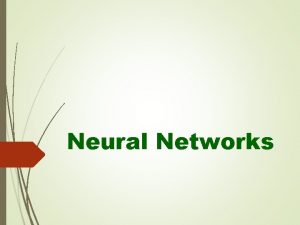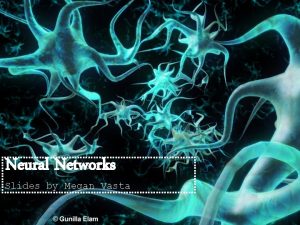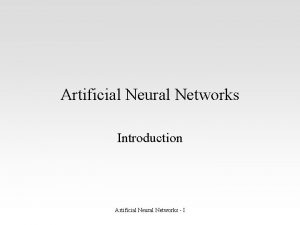Neural Networks 2 CS 446 Machine Learning 1










































- Slides: 42

Neural Networks 2 CS 446 Machine Learning 1

Administrative HW 5 is out. Due on April 11 No class on Thursday Slides are released. Try to follow the pdf. (since these slides are made in keynote, and exporting to ppt does not work well) Corrections regarding derivative in the last slide 2

What did we learn in last class ? 3

Basic Unit : Neuron x 1 x 2 w 1 w 2 o wn xn Note that we can write this as 4

Stack them up x 1 o 1 x 2 ok Output Layer xn Input Layer Hidden Layer Feedforward Neural Network This allows us to capture complex non-linear functions of the input data 5

Derivation of Learning Rule i j Connection wij between hidden and output layer is updated as 6

Derivation of Learning Rule j i Connection wij between input and hidden layer is updated as where utput units. Then, back propagate this error layer by layer through the network, changing w 7

The Backpropagation Algorithm For each example in the training set, do: 1. Compute the network output for this example 2. Compute the error term between he output and target values 3. For each output unit j, compute error term: 4. For each hidden unit, compute error term 5. Update weights by Questions ? ? 8

Today’s Plan Recurrent Neural Networks (and applications to NLP) Convolutional Neural Networks (and applications to Vision) 9

Recurrent Neural Networks 10

Motivation Not all problems can be converted into one with fixed length inputs and outputs Machine Translation : translating English sentence to other language Speech Recognition : translating spoken sentence to written sentence Hard or impossible to choose a large enough window, there can always be a new sentence longer than anything seen 11

Recurrent Neural Networks • Recurrent Neural Networks take as input each element of a sequence one by one. (Think of this as taking input x 1 at time step 1, x 2 at time step 2, etc) • Recurrent Neural Networks take the previous output or hidden states as inputs. • The composite input at time t has some historical information about the happenings at time T < t • RNNs are useful as their intermediate values (state) can store information about past inputs for a time that is not fixed a priori 12

RNN cell Input at time t is xt State at the end of time (t-1) is ht-1 State at the end of time t is ht You can obviously replace tanh by your favorite non-linear differentiable function How is it different from a standard neuron ? ? 13

Feeding a sequence to an RNN You can output yt at each time step (based on your problem), based on ht often linear function of ht Finally define error Et based on yt and the target output at time t GTt is target at time t 14

RNNs • Note that the weights are shared over time • Essentially, copies of the RNN cell are made over time (unrolling/unfolding), with different inputs at different time steps 15

Sentiment Classification Classify a restaurant review from Yelp or movie review from IMDB as positive or negative Inputs : Multiple words, one or more sentences Outputs : Positive or negative classification “The food was really good” “Don’t try the pizza, its so good you will come back everyday. I hate this place. ” 16

Sentiment Classification 17

Sentiment Classification 18

Input Output Scenario Feed-forward network Image captioning Sentiment classification Translation 19

Backpropagation though Time • Treat the unfolded network as one big feed-forward network • This unfolded network accepts the whole time series as input • The weight update is computed for each copy in the unfolded network, then summed (or averaged) and then applied to RNN weights 20

An Issue With RNNs Recall, back propagation requires computation of gradients with respect to each variable. For RNNs, consider the gradient of Et with respect to h 1 Product of a lot of terms can shrink to zero (vanishing gradient) or explode to infinity (exploding gradient). Exploding gradients are often controlled by clipping the values to a max value. One way to handle vanishing gradient problem is to try to have some relationship between ht and ht-1 such that each Long Short Term Memory (LSTM) try to do that, but vanishing gradients still a problem. As a result, capturing long range dependencies is still challenging. 21

Summary • RNNs allow for processing of variable length inputs and outputs by maintaining state information across time steps • Various input / output scenarios possible (Single / Multiple) • Exploding gradients are handled by gradient clipping, LSTMs are a way towards handling vanishing gradients. You can read more about LSTMs at http: //arunmallya. github. io/. A major part of RNN slides were taken from there. Questions ? ? 22

Convolutional Neural Networks 23

Motivation Grayscale Image is rectangular matrix of pixel values (intensity values) How to remove the noise in the photograph ? This picture and many others taken from slides of Prof. Lana Lazebnik 24

Moving Average • Lets replace each pixel with a weighted average of its neighborhood • The weights are called the filter kernel • What are the weights for the average of a 3 * 3 neighborhood ? For each pixel p, place this matrix with the pixel p at the center. Perform point wise multiplication of matrix with pixel values, and average them. Make this the new value of pixel p. 25

Convolution Let f be the image and g be the kernel. The output of convolving f with g is denoted f*g Convention: kernel is flipped 26

Practice with Linear Filters Original Filtered (No change) 27

Practice with Linear Filters Original Shifted left by 1 pixel 28

Practice with Linear Filters Original Blur (with a box filter) 29

Practice with Linear Filters Original Sharpening filter - increases differences with local average 30

Sharpening Filters can be used for sharpening, edge detection and extracting many other properties. See https: //en. wikipedia. org/wiki/Kernel_(image_processing) for more examples. Main idea behind Convolutional Neural Networks: use learned filters 31

Convolution Layer Each local region of the image is connected to a node in the next layer Weights are shared. Distribution of weight in the red connections will be the same as the weight distribution of the green connections, and so on, because they represent the same filter. Much less number of parameters than fully connected layers we saw in last class 32

Convolution Layer You can also use multiple filters on your image, all of them will be learnt You can add non-linearity at the output of a convolutional layer 33

Convolution Layer Colored images have 3 channels for RGB, so the input is a 3 D matrix instead of 2 D matrix. How to compute convolution there ? You will now need to perform 2 D convolution with a 3 D filter / kernel matrix. The third dimension of the filter matrix has to match the number of channels. Each neuron in the convolutional layer is connected only to a local region in the input volume spatially, but to the full depth (i. e. all color channels). Questions ? ? 34

Pooling Layer Look at each window and compute max value Function is to progressively reduce the spatial size of the representation to reduce the amount of parameters and computation in the network, and hence to also control overfitting You can use other functions for pooling, like average, L 2 norm, etc. but max is the most popular now 35

Some Facts • Both the convolutional layer and the pooling layer can reduce the size of the input. How ? • Stride : You do not have to apply filter to each consecutive pixel. You can only apply filter once every 2 pixels (stride = 2), etc. • Usually convolution layers use stride of 1, so does not reduce image response size • Pooling layers use stride of 2, halves the height and width of image response. Deep CNNs usually apply multiple convolution and pooling layers to compute rich features as well as reduce the image/response size 36

An example: VGG Thickness of each block corresponds to number of channels of the response / output. Height and width correspond to height and width of response / output. Think of this as stacking several feature extractors, higher stages compute more global, more invariant features 138 million parameters 37

An example: VGG CONV 3 -64 : convolutional layer with filters 3*3*(number of input channels), and 64 such filters are used. Each filter output also passed through Relu activation. Convolutions have stride of 1, so size remains same. 38

An example: VGG POOL 2 : Max pooling done on windows of 2*2 with stride of 2, so the height, width gets halved FC : indicates fully connected layer, as you saw in standard feed forward network 39

Object Detection Performance Image. Net Challenge Top 5 error 40

Summary • Filters are used to extract different properties of an image • Convolution neural networks use multiple layers of learned filters (convolution layers) • Convolution layers used along side pooling layers (eg. VGG net) • Each layer may or may not have parameters (e. g. CONV / FC do, RELU / POOL don’t) 41

42
 Neural networks and learning machines 3rd edition
Neural networks and learning machines 3rd edition Few shot learning with graph neural networks
Few shot learning with graph neural networks Neural networks and learning machines
Neural networks and learning machines Visualizing and understanding convolutional neural networks
Visualizing and understanding convolutional neural networks Vc dimension of neural networks
Vc dimension of neural networks Formation of neural networks ib psychology
Formation of neural networks ib psychology Audio super resolution using neural networks
Audio super resolution using neural networks Convolutional neural networks for visual recognition
Convolutional neural networks for visual recognition Leon gatys
Leon gatys Nvdla
Nvdla Mippers
Mippers Convolutional neural networks ppt
Convolutional neural networks ppt Rnn
Rnn Toolbox neural network matlab
Toolbox neural network matlab Neural networks for rf and microwave design
Neural networks for rf and microwave design 11-747 neural networks for nlp
11-747 neural networks for nlp Perceptron xor
Perceptron xor Sparse convolutional neural networks
Sparse convolutional neural networks On the computational efficiency of training neural networks
On the computational efficiency of training neural networks Tlu neural networks
Tlu neural networks Fuzzy logic lecture
Fuzzy logic lecture Xooutput
Xooutput Lmu cis
Lmu cis Deep forest towards an alternative to deep neural networks
Deep forest towards an alternative to deep neural networks Convolutional neural networks
Convolutional neural networks Neuraltools neural networks
Neuraltools neural networks Rnn andrew ng
Rnn andrew ng Predicting nba games using neural networks
Predicting nba games using neural networks The wake-sleep algorithm for unsupervised neural networks
The wake-sleep algorithm for unsupervised neural networks Bharath subramanyam
Bharath subramanyam Convolutional neural network alternatives
Convolutional neural network alternatives O homem que calculava malba tahan
O homem que calculava malba tahan Mestre o mar se revolta
Mestre o mar se revolta 446 alta road, suite 5300
446 alta road, suite 5300 Mischief rule of interpretation
Mischief rule of interpretation Intrinsic aids examples
Intrinsic aids examples 446 pessoas
446 pessoas Troop 446 pearland
Troop 446 pearland A switch in a datagram network uses a
A switch in a datagram network uses a Backbone networks in computer networks
Backbone networks in computer networks Concept learning task in machine learning
Concept learning task in machine learning Analytical learning in machine learning
Analytical learning in machine learning Pac learning model in machine learning
Pac learning model in machine learning

